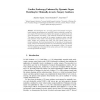Free Online Productivity Tools
i2Speak
i2Symbol
i2OCR
iTex2Img
iWeb2Print
iWeb2Shot
i2Type
iPdf2Split
iPdf2Merge
i2Bopomofo
i2Arabic
i2Style
i2Image
i2PDF
iLatex2Rtf
Sci2ools
MICCAI
2003
Springer
2003
Springer
Cardiac Endoscopy Enhanced by Dynamic Organ Modeling for Minimally-Invasive Surgery Guidance
Abstract. The development of a 3D image guidance environment will significantly enhance the performance of minimally invasive robotically assisted cardiac surgery. We have previously reported early progress on generation of such virtual environment, and linking it with traditional modalities like endoscopy. This paper discusses one aspect of the surgical navigation system: near-real time animation of the model of the beating heart phantom based on CT volumetric images, and overlaying the virtual view with optical images from a tracked endoscope. We have demonstrated that in the plane of the endoscopic image, normal to the endoscope optical axis, and intersecting the heart surface, the real and virtual endoscopic images can be registered to within ?2.6 mm and +0.8 mm depending on the phase of the cardiac cycle, and with almost negligible time lag between the images.
CT Volumetric Images | Endoscope Optical Axis | Medical Imaging | MICCAI 2003 | Virtual Endoscopic Images |
| Added | 15 Nov 2009 |
| Updated | 15 Nov 2009 |
| Type | Conference |
| Year | 2003 |
| Where | MICCAI |
| Authors | Stanislaw Szpala, Gerard Guiraudon, Terry M. Peters |
Comments (0)

